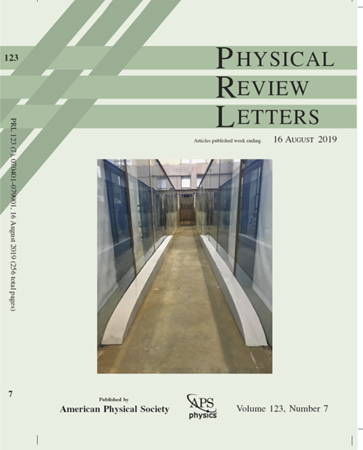环状雷德贝格质子与内壳激发的四极耦合
IF 8.1
1区 物理与天体物理
Q1 PHYSICS, MULTIDISCIPLINARY
引用次数: 0
摘要
二价原子由于具有第二个光学活性价电子,为推进基于雷德贝格原子的量子模拟和计算的控制提供了绝佳手段。在这种情况下,圆雷德贝格原子尤其有前途,因为可以利用其长寿命离子核激发,而不会产生有害的自电离。在此,我们报告了在可陨落的 4D3/2 电平与极高 n(n=79)的圆雷德贝格四元位之间实现电四极耦合的情况,该耦合是在由光学镊子阵列制备的双激发 Sr88 原子中实现的。我们通过包含自旋回波的节拍节点拉姆齐干涉测量法测量了圆形雷德贝格量子比特的千赫兹级差电平位移。观测这种耦合需要对雷德贝格态进行超过 100 μs 的相干询问,而这需要在黑体辐射抑制电容器中通过镊子捕获和圆态寿命增强来实现。此外,我们还发现,在离子核心的连续光子散射作用下,量子比特的相干性没有明显的损失,这为激光冷却和雷德贝格原子成像铺平了道路。我们的研究成果证明了在雷德贝格原子中存在微弱的电子-电子相互作用,并扩展了量子模拟工具箱,通过离子核心操纵对高度激发的圆态量子比特进行光学控制。本文章由计算机程序翻译,如有差异,请以英文原文为准。

Quadrupole Coupling of Circular Rydberg Qubits to Inner Shell Excitations
Divalent atoms provide excellent means for advancing control in Rydberg atom-based quantum simulation and computing due to the second optically active valence electron available. Particularly promising in this context are circular Rydberg atoms, for which long-lived ionic core excitations can be exploited without suffering from detrimental autoionization. Here, we report the implementation of electric quadrupole coupling between the metastable level and a very high- () circular Rydberg qubit, realized in doubly excited atoms prepared from an optical tweezer array. We measure the kHz-scale differential level shift on the circular Rydberg qubit via beat-node Ramsey interferometry comprising spin echo. Observing this coupling requires coherent interrogation of the Rydberg states for more than , which is assisted by tweezer trapping and circular state lifetime enhancement in a black-body radiation suppressing capacitor. Further, we find no noticeable loss of qubit coherence under continuous photon scattering on the ion core, paving the way for laser cooling and imaging of Rydberg atoms. Our results demonstrate access to weak electron-electron interactions in Rydberg atoms and expand the quantum simulation toolbox for optical control of highly excited circular state qubits via ionic core manipulation.
求助全文
通过发布文献求助,成功后即可免费获取论文全文。
去求助
来源期刊

Physical review letters
物理-物理:综合
CiteScore
16.50
自引率
7.00%
发文量
2673
审稿时长
2.2 months
期刊介绍:
Physical review letters(PRL)covers the full range of applied, fundamental, and interdisciplinary physics research topics:
General physics, including statistical and quantum mechanics and quantum information
Gravitation, astrophysics, and cosmology
Elementary particles and fields
Nuclear physics
Atomic, molecular, and optical physics
Nonlinear dynamics, fluid dynamics, and classical optics
Plasma and beam physics
Condensed matter and materials physics
Polymers, soft matter, biological, climate and interdisciplinary physics, including networks
 求助内容:
求助内容: 应助结果提醒方式:
应助结果提醒方式:


